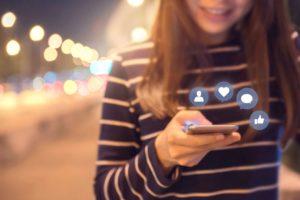 Social media is a powerful force. It has the ability to connect family and friends from all over the world, create a sense of belonging and offer support – especially during this current health crisis. But it can also stir up negativity, spread misinformation and heighten worries.
Social media is a powerful force. It has the ability to connect family and friends from all over the world, create a sense of belonging and offer support – especially during this current health crisis. But it can also stir up negativity, spread misinformation and heighten worries.
About 3.8 billion people – more than half the world’s population – are now on social media, according to Digital 2020 reports.
“Social media is here to stay, but we need to create boundaries in our lives with it,” says Erin Grimm, a social media-marketing expert in Scottsdale, Ariz. “There’s an intention when you’re scrolling, and you need to ask yourself, what is the purpose, what am I getting out of it?”
Falsehoods and Fear Run Rampant on the Internet
 With the coronavirus outbreak, social media has taken on even greater importance. It’s how we connect with loved ones while we self-quarantine and how we stay abreast of the latest health advisories. But too much time spent on social media can make us even more fearful and anxious. Social media is also a breeding ground for misinformation and sensationalism where people are spreading conspiracy theories and falsehoods about the virus, stirring up more worries and paranoia.
With the coronavirus outbreak, social media has taken on even greater importance. It’s how we connect with loved ones while we self-quarantine and how we stay abreast of the latest health advisories. But too much time spent on social media can make us even more fearful and anxious. Social media is also a breeding ground for misinformation and sensationalism where people are spreading conspiracy theories and falsehoods about the virus, stirring up more worries and paranoia.
“The combination of social media and COVID-19 has created a panic and focus like I have not ever seen,” says Grimm. “Either posts have ‘stats’ and other frightening information or someone is posting a puzzle or hike …but it’s all centered around one thing – the pandemic.”
When people go online and urge their followers to stock up on a five month’s supply of meat and canned goods or get angry when they find empty shelves at the grocery store, panic-buying and fear spread faster than the coronavirus itself, and people run to the store and hoard grocery items that they didn’t even know they needed. Workers who have lost their jobs and business owners who have shuttered their businesses post about their hardships and hopelessness, and we feel their pain.
“For many, social media can be an escape, but now there truly is no escape,” says Grimm. “Fear of not being prepared, fear of the unknown…We are constantly reminded and it’s not healthy.”
Find Positive Ways to Connect
 With the social void we’re all experiencing right now, it’s normal to feel lonely, depressed or anxious. Instead of feeding the frenzy of fear, use your digital devices to connect in a positive way by getting on Skype or FaceTime and interacting with loved ones, or sharing uplifting pictures and words of comfort on your favorite social media platform.
With the social void we’re all experiencing right now, it’s normal to feel lonely, depressed or anxious. Instead of feeding the frenzy of fear, use your digital devices to connect in a positive way by getting on Skype or FaceTime and interacting with loved ones, or sharing uplifting pictures and words of comfort on your favorite social media platform.
The Internet is filled with stories of people volunteering to bring groceries to the elderly or sharing toilet paper and basic food supplies with neighbors who have run out. Fitness and yoga teachers are reaching out to their students and posting free online classes and meditation sessions to give them an easy way to burn off calories and release tension.
However, as with any crisis, scam artists and Internet trolls are also out in full force, looking to take advantage of people when they are most vulnerable. Be wary of who you friend or follow and don’t share personal information with anyone online.
Take Control of Your Social Media Use
 The average American spends more than two hours a day scrolling through Facebook feeds, watching YouTube videos, posting Instagram photos and catching up on Twitter. But with schools and most businesses closed down and so much extra time on our hands, it’s easy to double or even quadruple the amount of time spent on social media.
The average American spends more than two hours a day scrolling through Facebook feeds, watching YouTube videos, posting Instagram photos and catching up on Twitter. But with schools and most businesses closed down and so much extra time on our hands, it’s easy to double or even quadruple the amount of time spent on social media.
“Before you go on social media, ask yourself, what is this bringing to my life?” advises Grimm. “We can get caught up in negativity and not even mean to…Think before you post, why am I posting this? If it’s not positive or helpful, don’t post it.”
Like the novel coronavirus, most of what happens around us is out of our control. But we can control who we follow, what we post and how much time we spend on social media.